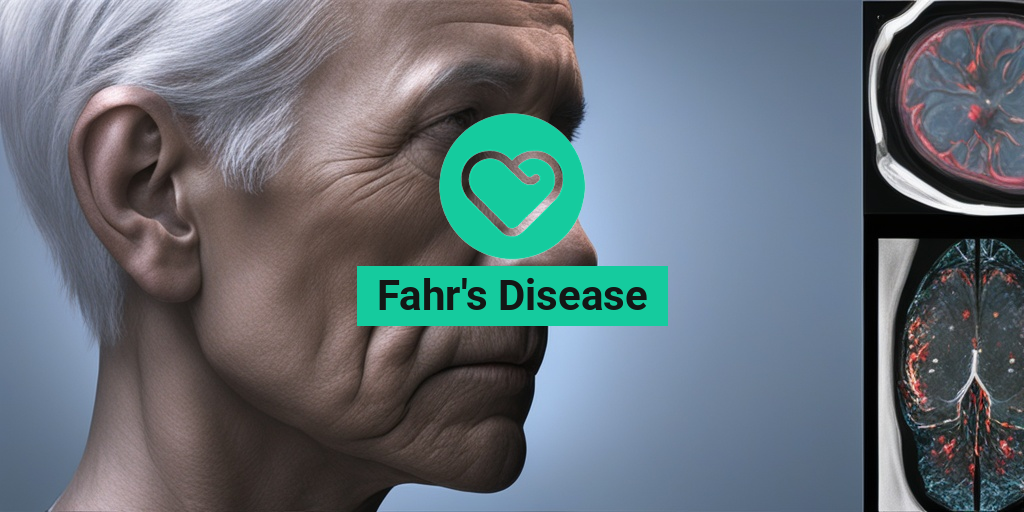What Is Fahr’s Disease?
Fahr’s disease, also known as Fahr’s syndrome or idiopathic basal ganglia calcification (IBGC), is a rare genetic disorder that affects the brain. It is characterized by the abnormal deposition of calcium in the brain, particularly in the basal ganglia region. This condition can lead to a range of neurological symptoms and can significantly impact a person’s quality of life.
Causes and Inheritance
The exact cause of Fahr’s disease is still not fully understood, but it is believed to be related to genetic mutations. Research suggests that the disease is inherited in an autosomal dominant pattern, meaning that a single copy of the mutated gene is enough to cause the condition. This means that if one parent has the disease, each child has a 50% chance of inheriting it.
Prevalence
Fahr’s disease is a rare condition, and its exact prevalence is not well established. However, it is estimated to affect approximately 1 in 1 million people worldwide. The disease can affect people of all ages, but symptoms typically appear in adulthood, often between the ages of 30 and 60.
Fahr’s Disease Symptoms
The symptoms of Fahr’s disease can vary widely from person to person, and may include:
- Movement disorders: Such as dystonia, chorea, and parkinsonism, which can cause involuntary movements, tremors, and muscle stiffness.
- Seizures: Fahr’s disease can cause seizures, which can range from mild to severe.
- Cognitive impairment: Some people with Fahr’s disease may experience cognitive decline, including memory loss, confusion, and difficulty with concentration.
- Psychiatric symptoms: Depression, anxiety, and mood swings are common in people with Fahr’s disease.
- Vision problems: Fahr’s disease can cause vision loss, blurred vision, and eye movement abnormalities.
- Hearing loss: Some people with the disease may experience hearing loss or tinnitus (ringing in the ears).
- Speech difficulties: Fahr’s disease can cause speech difficulties, including dysarthria (slurred speech) and aphasia (difficulty with language).
It’s essential to note that not everyone with Fahr’s disease will experience all of these symptoms, and the severity of the condition can vary widely from person to person. If you or a loved one is experiencing any of these symptoms, it’s crucial to consult with a healthcare professional for an accurate diagnosis and appropriate treatment.
Stay tuned for the next part of this series, where we’ll explore the diagnosis, treatment, and prognosis of Fahr’s disease. In the meantime, if you have any questions or concerns about this condition, feel free to ask in the comments below! 💬
For more information on Fahr’s disease and other health topics, be sure to check out Yesil Health AI, a valuable resource for evidence-based health answers. 🌟

Fahr’s Disease Causes and Risk Factors
Fahr’s disease, also known as Fahr’s syndrome or idiopathic basal ganglia calcification, is a rare neurological disorder characterized by abnormal calcium deposits in the brain. While the exact causes of Fahr’s disease are still not fully understood, research has identified several risk factors that may contribute to its development.
Genetic Factors
Studies suggest that Fahr’s disease may have a strong genetic component. In some cases, the disease appears to be inherited in an autosomal dominant pattern, meaning that a single copy of the mutated gene is enough to cause the condition. However, the specific genes responsible for Fahr’s disease have not been identified, and more research is needed to understand the genetic mechanisms underlying the disease.
Environmental Factors
Environmental factors, such as exposure to toxins or certain medications, may also play a role in the development of Fahr’s disease. For example, some research suggests that exposure to lead or other heavy metals may contribute to the formation of calcium deposits in the brain. Additionally, certain medications, such as antacids or calcium supplements, may increase the risk of developing Fahr’s disease.
Other Risk Factors
Other risk factors that may contribute to the development of Fahr’s disease include:
- Age: Fahr’s disease typically affects people between the ages of 30 and 60, although it can occur at any age.
- Family history: Having a family history of Fahr’s disease or other neurological disorders may increase the risk of developing the condition.
- Head trauma: Trauma to the head may increase the risk of developing Fahr’s disease, although the exact mechanism is not clear.
It’s essential to note that the exact causes of Fahr’s disease are still not fully understood, and more research is needed to identify the underlying mechanisms and risk factors.
Fahr’s Disease Diagnosis
Diagnosing Fahr’s disease can be challenging, as the symptoms are often similar to those of other neurological disorders. A diagnosis typically involves a combination of clinical evaluation, laboratory tests, and imaging studies.
Clinical Evaluation
A healthcare provider will typically begin by performing a thorough clinical evaluation, including a physical examination and a review of the patient’s medical history. This may involve:
- Neurological examination: A healthcare provider will assess the patient’s cognitive function, motor skills, and reflexes.
- Medical history: A healthcare provider will review the patient’s medical history, including any previous illnesses or injuries.
Laboratory Tests
Laboratory tests may be ordered to rule out other conditions that may cause similar symptoms. These tests may include:
- Blood tests: Blood tests may be ordered to check for underlying infections or inflammatory conditions.
- Genetic testing: Genetic testing may be ordered to identify any genetic mutations that may be associated with Fahr’s disease.
Imaging Studies
Imaging studies, such as computed tomography (CT) or magnetic resonance imaging (MRI), are often used to confirm the diagnosis of Fahr’s disease. These studies can help identify:
- Calcifications: Imaging studies can help identify the characteristic calcium deposits in the brain.
- Brain structure: Imaging studies can help assess the structure and function of the brain.
A diagnosis of Fahr’s disease is typically made based on the presence of characteristic symptoms, laboratory test results, and imaging studies. However, a definitive diagnosis may require a combination of these factors and may involve consultation with a specialist, such as a neurologist or geneticist.

Fahr’s Disease Treatment Options
Fahr’s disease, a rare genetic disorder, can be challenging to manage, but with the right treatment options, patients can experience significant improvements in their quality of life. While there is no cure for Fahr’s disease, various treatments can help alleviate symptoms, slow down disease progression, and improve overall well-being.
Medications
Several medications can help manage the symptoms of Fahr’s disease. These include:
- Dopamine agonists: These medications, such as ropinirole and pramipexole, can help manage Parkinson’s-like symptoms, including tremors, rigidity, and bradykinesia.
- Anticholinergics: Medications like trihexyphenidyl can help reduce muscle stiffness and tremors.
- Benzodiazepines: These medications, such as clonazepam, can help manage anxiety, seizures, and muscle spasms.
- Anticonvulsants: Medications like valproate and lamotrigine can help control seizures.
Therapies
In addition to medications, various therapies can help patients with Fahr’s disease. These include:
- Physical therapy: A physical therapist can help patients improve their mobility, balance, and coordination.
- Occupational therapy: An occupational therapist can help patients develop strategies to maintain their independence and perform daily activities.
- Speech therapy: A speech therapist can help patients improve their communication skills and address any swallowing difficulties.
Surgical Interventions
In some cases, surgical interventions may be necessary to manage the symptoms of Fahr’s disease. These can include:
- Deep brain stimulation: This surgical procedure involves implanting a device that stimulates the brain to help manage Parkinson’s-like symptoms.
- Bilateral pallidotomy: This surgical procedure involves destroying a part of the brain called the globus pallidus to help manage dystonia and other movement disorders.
Fahr’s Disease Complications
Fahr’s disease can lead to several complications if left untreated or poorly managed. These complications can significantly impact a patient’s quality of life and overall well-being.
Neurological Complications
Fahr’s disease can lead to various neurological complications, including:
- Dystonia: Abnormal muscle contractions can lead to twisting, repetitive movements, and abnormal postures.
- Seizures: Fahr’s disease can increase the risk of seizures, which can be life-threatening if not properly managed.
- Cognitive impairment: Patients with Fahr’s disease may experience cognitive decline, including memory loss, confusion, and difficulty with concentration.
Psychological Complications
Fahr’s disease can also lead to psychological complications, including:
- Depression: The emotional toll of living with a rare genetic disorder can lead to depression, anxiety, and mood swings.
- Anxiety: Patients with Fahr’s disease may experience anxiety, fear, and uncertainty about their condition and its impact on their future.
It’s essential for patients with Fahr’s disease to work closely with their healthcare team to manage their symptoms, prevent complications, and improve their overall quality of life. 💊

Fahr’s Disease and Brain Calcification
Fahr’s disease, also known as Fahr’s syndrome or idiopathic basal ganglia calcification, is a rare genetic disorder characterized by abnormal calcium deposits in the brain. These deposits, also known as calcifications, can lead to a range of symptoms and complications that affect an individual’s quality of life.
What are Brain Calcifications?
Brain calcifications are abnormal deposits of calcium in the brain tissue. In the case of Fahr’s disease, these calcifications typically occur in the basal ganglia, a region of the brain responsible for movement, cognition, and emotion regulation. The calcifications can be small or large, and their size and location can impact the severity of symptoms.
Causes of Brain Calcification in Fahr’s Disease
The exact cause of brain calcification in Fahr’s disease is still not fully understood. However, research suggests that it may be related to genetic mutations that affect the metabolism of calcium in the brain. In some cases, the disease may be inherited in an autosomal dominant pattern, meaning that a single copy of the mutated gene is enough to cause the condition.
Symptoms of Brain Calcification in Fahr’s Disease
The symptoms of brain calcification in Fahr’s disease can vary widely depending on the location and size of the calcifications. Common symptoms include:
- Movement disorders, such as dystonia, chorea, and parkinsonism
- Seizures
- Cognitive impairment, including memory loss and difficulty with concentration
- Emotional changes, such as depression, anxiety, and mood swings
- Vision problems, including blurred vision and eye movement abnormalities
In some cases, brain calcification can also lead to more severe complications, such as stroke, severe cognitive decline, and even death.
Fahr’s Disease Prognosis and Outlook
The prognosis and outlook for individuals with Fahr’s disease vary depending on the severity of symptoms, the size and location of brain calcifications, and the effectiveness of treatment. While there is currently no cure for Fahr’s disease, various treatments can help manage symptoms and improve quality of life.
Treatment Options
Treatment for Fahr’s disease typically focuses on managing symptoms and slowing disease progression. This may include:
- Medications to control seizures, movement disorders, and emotional changes
- Physical therapy to improve mobility and balance
- Speech therapy to address communication difficulties
- Cognitive therapy to improve cognitive function
In some cases, surgery may be necessary to remove large calcifications or to relieve pressure on surrounding brain tissue.
Genetic Testing and Counseling
Genetic testing can help identify individuals with a family history of Fahr’s disease, allowing for early intervention and counseling. Genetic counseling can also provide guidance on the risks of passing the condition to offspring.
While Fahr’s disease is a challenging condition, with proper treatment and support, individuals can lead fulfilling lives. It’s essential for those affected to stay informed, seek support from loved ones and healthcare professionals, and advocate for further research into this rare and complex condition 💪.

Fahr’s Disease: Frequently Asked Questions
Fahr’s disease is a rare genetic disorder that affects the brain and can cause a range of symptoms. Here are some frequently asked questions about Fahr’s disease:
What is Fahr’s Disease?
Fahr’s disease, also known as Fahr’s syndrome or idiopathic basal ganglia calcification, is a rare genetic disorder that affects the brain. It is characterized by abnormal calcium deposits in the brain, particularly in the basal ganglia region.
What are the Symptoms of Fahr’s Disease?
The symptoms of Fahr’s disease can vary widely from person to person, but may include:
- Movement disorders, such as dystonia, chorea, or parkinsonism
- Seizures
- Weakness or numbness in the face, arms, or legs
- Difficulty with speech or swallowing
- Cognitive impairment or dementia
- Psychiatric symptoms, such as depression or anxiety
How is Fahr’s Disease Diagnosed?
Fahr’s disease is typically diagnosed through a combination of:
- Medical history and physical examination
- Imaging tests, such as CT or MRI scans, to visualize the brain and detect calcium deposits
- Genetic testing to identify mutations in the genes responsible for the condition
Is There a Cure for Fahr’s Disease?
Unfortunately, there is no cure for Fahr’s disease. However, treatment can help manage the symptoms and slow the progression of the condition. Treatment may include:
- Medications to control seizures, movement disorders, or psychiatric symptoms
- Physical therapy to improve mobility and balance
- Speech therapy to improve communication
- Occupational therapy to improve daily functioning
Is Fahr’s Disease Inherited?
Fahr’s disease can be inherited in an autosomal dominant pattern, meaning that a single copy of the mutated gene is enough to cause the condition. However, not everyone with a family history of Fahr’s disease will develop the condition.
What is the Prognosis for Fahr’s Disease?
The prognosis for Fahr’s disease varies widely depending on the severity of the symptoms and the age of onset. In general, the prognosis is poor, and the condition can lead to significant disability and reduced life expectancy.
Where Can I Find More Information About Fahr’s Disease?
There are several organizations and resources available to provide more information and support for individuals with Fahr’s disease, including:
- The Fahr’s Disease Society
- The National Institute of Neurological Disorders and Stroke (NINDS)
- The Genetic and Rare Diseases Information Center (GARD)
We hope this FAQ has been helpful in providing more information about Fahr’s disease. If you have any further questions or concerns, please don’t hesitate to reach out to a healthcare professional or a support organization. 🤝




